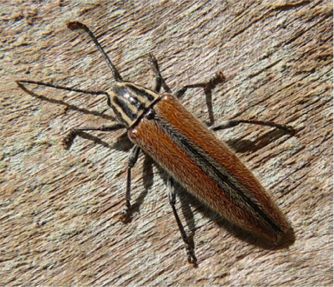
|
|
|
Dorsal - High resolution photos |
Ventral - Discussion of Behavior |
Return to Texas Entomology - Compiled by Mike Quinn

|
|
|
Dorsal - High resolution photos |
Ventral - Discussion of Behavior |
One individual was found on a fishing pier in Port
O'Connor,
Possibly attracted to the pier's fishing lights the previous night.
|
|
Beetle only known in Texas from Port O'Connor, Calhoun County
Range:
Florida, Georgia, and now this record from Texas. Florida distribution of Osmopleura chamaeropis.
Georgia, Charlton County, May. (Fattig, 1947).
Adult Activity: May-June.
Habitat: In Florida, this beetle occurs in pine-palmetto woodlands.
Abundance: Rarely encountered but can be locally abundant (Thomas, 1994; Turnbow & Hovore, 1979)
Size: 1.1 inches (28 mm) in length
Similar species: Osmopleura is a monotypic genus.
Larval Host:
In Florida Osmopleura chamaeropis feeds on Cabbage Palm - Sabal palmetto - The State Tree of Florida
Historically S. palmetto was primarily restricted to the Florida peninsula and coastal Georgia in the U.S. (see range map below).
The known distribution of Osmopleura chamaeropis overlaps with the historical range of Sabal palmetto in the U.S.
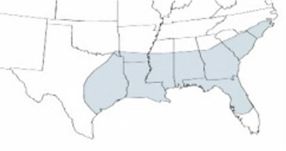
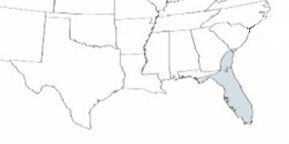
Sabal minor - new host?
Sabal palmetto - known host
Sabal ranges per Flora of North America
Sabal palmetto has been widely planted well beyond its historical range. For example, South Carolina is called the Palmetto State and has the palm tree on the state seal as well as the flag. The following excerpt from Gilman & Watson (1994) explains some of the reasons why S. palmetto has been so widely transplanted:
Cabbage Palm is about as hurricane-proof as a tree can be. They stand after many hurricanes have blown over the oaks and snapped the pines in two. Cabbage Palm is exceptionally easy to transplant and will thrive in full sun or partial shade. It will adapt to slightly brackish water as well as dry, sandy locations and requires no special care once established. Although one of the hardier palms, 11-degrees F. killed about twenty-five percent of the Cabbage Palms in 1983 in Baton Rouge. Cabbage Palms are generally collected from existing stands and are not grown in nurseries. Seeds germinate readily in the landscape, generating many seedlings.
Landon Lockett (pers. comm. 2007) offers the following insight into S. palmetto's origin and distribution in Texas:
In Texas S. palmetto is typically found in front of banks and Taco Cabanas, although there is a large wild population along Mulberry Creek, which loops around the little town of Praha, halfway between Houston and San Antonio. This is the only case I know of S. palmetto escaping into the wild in Texas. Although I’ve never investigated the matter I have heard that S. palmetto is commonly dug up in Florida and shipped to Texas. The beetles could be widespread in Texas already, although whatever damage they may do is not apparent.
Palm species are notoriously difficult to identify. There are a wide variety of arborescent fan palms in the older, eastern end of Port O'Connor where the cerambycid was found. The majority of these tall palms appear to be Sabal palmettos as their petioles or leaf stems lack the spines characteristic of Washingtonia palms. Most were planted prior to Hurricane Carla which came ashore near Port O’Connor and swept the coast with 120 mph winds on September 11, 1961.
Given that Osmopleura chamaeropis has not been recorded hosting on Sabal minor in Florida or elsewhere, and that Sabal palmetto is widely transplanted along the Gulf Coast, it seems more likely that this record is due to one or more Cabbage Palm Beetles being transplanting along with one or more Sabal palmettos from Florida rather than a previously unknown beetle population hosting on Sabal minor in Port O'Connor.
Unusual defense behavior. It popped itself over and held it's body off the ground with its legs spread stiffly. It held this position for over 40 minutes and returned to it immediately if even slightly disturbed. (B. Freeman, pers. comm. 2007)
Doug Yanega (pers. comm. 2007) writes: I especially like the defensive posture! One can only suppose that it is some sort of mimetic/aposematic display. If I had to put money on it, I'd say it's pretending to be a Bembix or Bicyrtes - viewed from a distance, that's what the belly markings most closely resemble, and those wasps rest poised on the ground in a posture similar to the one the beetle is in. Certainly a novel mimetic behavior.
Model ?
Mimic ?
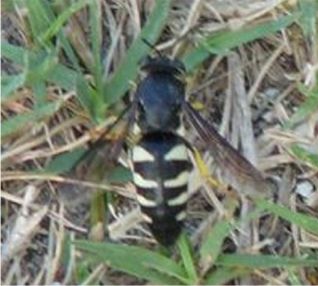
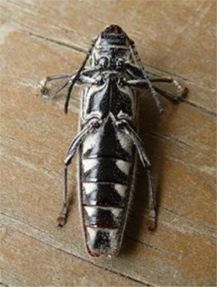
Bicyrtes quadrifasciatus
Osmopleura chamaeropis
Within days of Doug Yanega's suggestion of various wasps as a possible model for this beetle,
Brush Freeman got a quick shot the above wasp at Port O'Connor on June 12, 2007.Doug comments, "B. q. is a very common and widespread species that uses stinkbugs as larval provisions -
I think you'll agree that the beetle, when inverted, could easily be confused with this wasp."
Link to a high resolution dorsal/ventral photo of the beetle.
Note the similar angle of the beetle's antennae to the angle of the costal margin wasp's wings.
Also, note the odd precision of the crossed placement of the beetle's front and middle legs.
Other Possible Models (most from BugGuide.Net):
Family Crabronidae, Subfamily Bembicinae - Sand Wasps
Cabbage Palm Longhorn Web Links:
Osmopleura chamaeropis (Horn) - The Cerambycidae of Florida
Osmopleura chamaeropis (Horn) 1893 - Photographic Catalog of the Cerambycidae of the New World
Palmetto Longhorn - Osmopleura chamaeropis - BugGuide.Net
Collecting Methods:
Best to carefully search host plants or use a malaise trap, Lindgren funnel, or flight intercept trap as this species is apparently not attracted to lights or sugar (Dan Heffern, pers. comm. 2007). Insect Collecting Information
Etymology:
Osmopleura chamaeropis
osmo, -s, -t (G). Pushing, thrusting
pleur, -a, -i, -o, =um (G). The side; a ribcham, -ae, -e (G). On the ground, low
ropis - ??
Other U.S. Palm-associated Cerambycidae:
Tribe Agallissini:
Zagymnus clerinus (LeConte) - Florida, Georgia - (Is on the cover of: The Cerambycidae of Florida)
Agallissus lepturoides (Chevrolat in Orbigny 1844)Agallissus lepturoides is associated with palms in Central America and Texas. The two Texas (Cameron Co.) records are from about 1900 and 1990. (Dan Heffern, pers. comm., 2007)
Today, the only remaining large stands of palms in Cameron Co. are Sabal mexicana within the Sabal Palm Audubon Center, and to a lesser extent at the Nature Conservancy's Southmost Preserve
Arnett, R.H., Jr., M.C. Thomas, P.E. Skelley & J.H. Frank. (editors). 2002. American Beetles, Volume II: Polyphaga: Scarabaeoidea through Curculionoidea. CRC Press. 861 pp.
Borror, D.J. 1960. Dictionary of Word Roots and Combining Forms. National Press Books, Palo Alto. v + 134 pp.
Evans, H.E. 1966. The comparative ethology and evolution of the sand wasps. Harvard University Press, Cambridge. xvi + 526 pp.
Evans, H.E. & K.M. O'Neill. 2007. The Sand Wasps: Natural History and Behavior. Harvard University Press, Cambridge. 360 pp.
Fattig, P.W. 1947. The Cerambycidae or long-horned beetles of Georgia. Emory University Museum Bulletin 5, Atlanta, GA. 48 pp.
Horn, G.H. 1893. Miscellaneous coleopterous studies. Transactions of the American Entomological Society, 20: 136-144.
Hovore, F.T., R.L. Penrose & R.W. Neck. 1987. The Cerambycidae, or longhorned beetles, of southern Texas: a faunal survey (Coleoptera). Proceedings of the California Academy of Sciences, 44(13): 283-334, 20 figs.
Howard, F.W. 2001. Insects on Palms. CABI Publishing, Oxfordshire, UK. 400 pp.
Linsley, E.G. 1964. The Cerambycidae of North America. Part V. Taxonomy and classification of the subfamily Cerambycinae, tribes Callichromini through Ancylocerini. Univ. Calif. Publs Ent., Berkeley, 22: 1-197, 60 figs., 1 pl.
Monné, M.A. 2005. Catalogue of the Cerambycidae (Coleoptera) of the Neotropical Region. Part I. Subfamily Cerambycinae. Zootaxa, 946: 1-765.
Monné, M.A. & F.T. Hovore. 2005. Electronic Checklist of the Cerambycidae of the Western Hemisphere. 393 pp.
Peck, S.B., & M.C. Thomas. 1998. A distributional checklist of the beetles (Coleoptera) of Florida. Arthropods of Florida and Neighboring Land Areas, 16: i-viii + 1-180.
Thomas, M.C. 1994. Cabbage Palm Longhorn, Osmopleura chamaeropis (Horn). Pp. 472-474. in: M.A. Deyrup & R. Franz. (editors). Rare and endangered biota of Florida. Volume IV. Invertebrates. University Press of Florida, Gainesville. 798 pp.
Turnbow, R.H. Jr., & F.T. Hovore. 1979. Notes on Cerambycidae from the southeastern United States. Entomological News, 90(5): 219-229.
Yanega, D. 1996. Field guide to northeastern longhorn beetles (Coleoptera: Cerambycidae). Illinois Natural History Survey, Champaign. 6:1-184.
Sabal References:
Bomhard, M.L. 1935. Sabal louisiana, the correct name for the polymorphic palmetto of Louisiana. J. Wash. Acad. Sci. 25: 35-44.
Brown, K.E. 1976. Ecological studies of the cabbage palm, Sabal palmetto. Principes 20: 3-10, 49-56, 98-115, 148-157.
Gilman E.F. & D.G. Watson. 1994. Sabal palmetto: Cabbage Palm. Fact Sheet ST-575, a series of the Environmental Horticulture Department, Florida Cooperative Extension Service, Institute of Food and Agricultural Sciences, University of Florida. 3 pp.
Goldman, D.H. 1999. Distribution update: Sabal minor in Mexico. Palms 43: 40-44.
Lockett, L. 1991. Brazoria County Palms. Principes 35(2): 64-71.
Lockett, L. 1995. Historical Evidence of the Native Presence of Sabal
mexicana (Palmae) North of the Lower Rio Grande Valley. Sida, 16(4):
711-719.
Ramp, P.F. 1989. Natural History of Sabal minor: Demography, Population Genetics and Reproductive Ecology. Ph.D. dissertation. Tulane University.
Ramp, P.F. & L.B. Thien. 1995. A taxonomic history and reexamination of Sabal minor in the Mississippi Valley. Principes 39: 77-83.
Small, J.K. 1929. Palmetto-with-a-stem---Sabal deeringiana. J New York Bot. Gard. 30: 278-284.
Zona, S. 1990. A monograph of Sabal (Arecaceae: Coryphoideae). Aliso 12: 583-666.
01 Dec 2008 © Mike Quinn / Texas Entomology / Texas Beetle Information